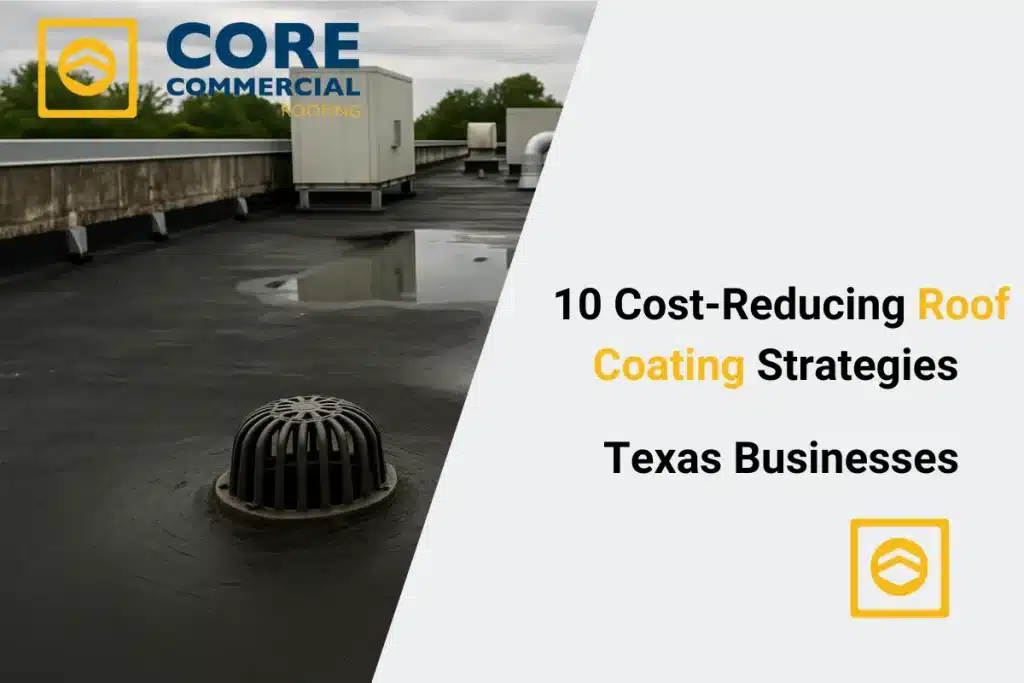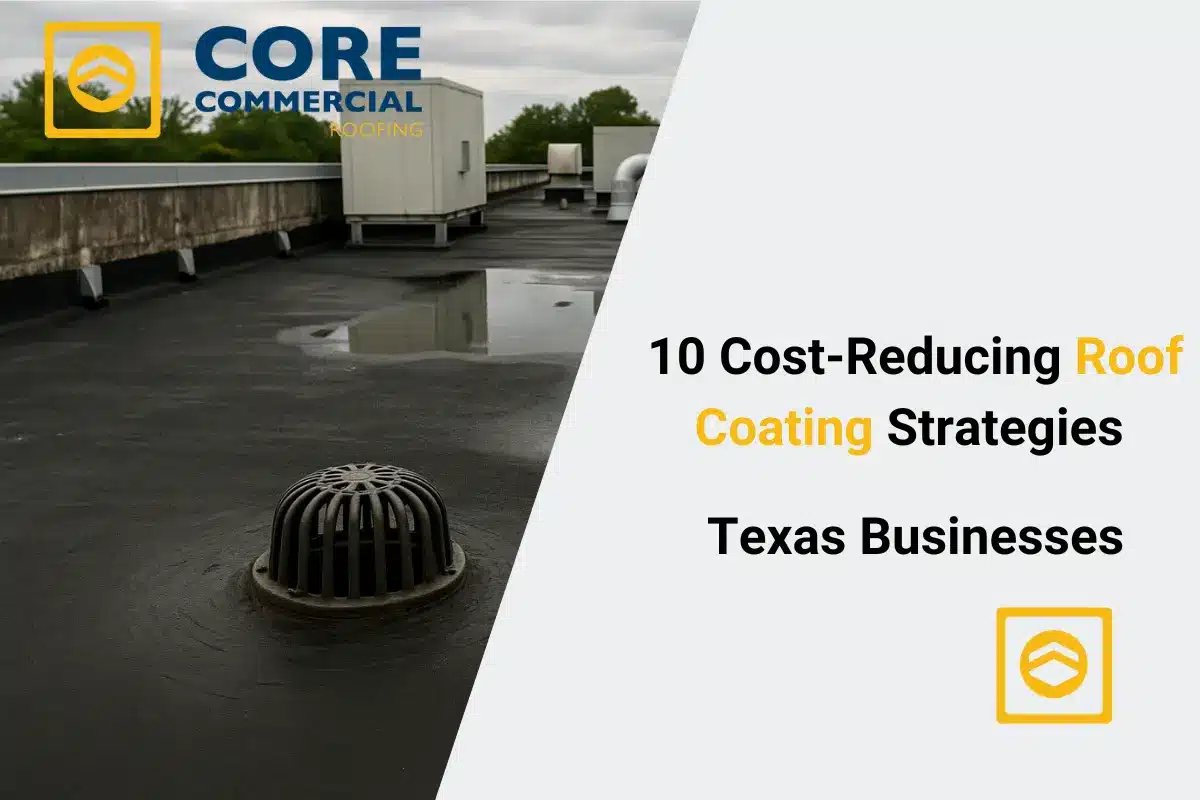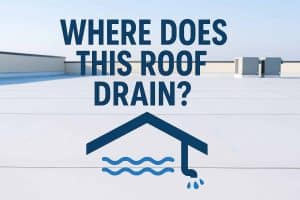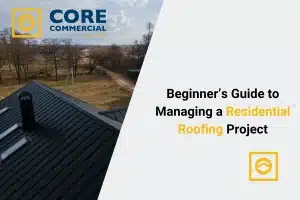In Texas, the brutal sun, sudden storms, and high humidity all take a toll on commercial roofs. Over time, businesses face costly damage from leaks, heat absorption, and wear, and those repair bills add up fast. That’s why smart business owners turn to roof coatings. These protective layers act like sunscreen and armor in one, helping your roof stay cooler, last longer, and cost less to maintain.
One approach we’ve seen deliver incredible long-term value is applying a reflective elastomeric coating. It seals minor cracks and reduces surface temperatures, which translates directly into energy savings and fewer AC breakdowns.
If your goal is to cut down on roofing costs, without cutting corners, this article gives you 10 proven coating strategies tailored for Texas businesses. Each solution is practical, affordable, and easy to understand. Keep reading to find the strategy that best fits your roof, budget, and long-term plans.

Table of Contents
1. What Makes Roof Coatings a Smart Investment in Texas
Texas weather creates ideal conditions for early roof failure. Scorching UV rays, frequent storms, and drastic temperature swings can break down even durable materials. Many business owners assume roof replacement is the only answer once issues show up. But before tearing off that roof, coatings offer a smarter, more cost-effective alternative.
Instead of replacing your entire roof, a coating adds a waterproof, UV-resistant layer on top of your existing material. This stops leaks, reduces indoor temperatures, and protects the roof from further breakdown. Most importantly, coating is often a fraction of the cost of replacement and can delay replacement for years.
If your goal is to stretch every dollar and avoid sudden roofing emergencies, a protective coating can deliver fast and long-term financial wins. That’s why so many Texas companies are making coatings a key part of their roofing strategy.
2. Elastomeric Roof Coatings: Stretch, Seal, and Save
Elastomeric roof coatings are one of the most flexible and reliable options out there. These coatings are designed to expand and contract with your roof as temperatures rise and fall a crucial benefit in Texas, where days often shift from blazing hot to cool and breezy in just a few hours.
Elastomeric coatings seal small cracks, stop leaks, and reduce thermal shock (the damage that happens from rapid temperature changes). They form a rubber-like layer over your roof that holds up under tough weather.
Key benefits include:
- Waterproof seal for flat and low-slope roofs
- Reflective surface that reduces roof temperature by up to 30%
- Reduced HVAC usage, which means lower electric bills
- Prevents expansion-related cracks, cutting repair costs
This option offers one of the best returns on investment for commercial buildings looking to lower costs while adding years of protection.
3. Silicone Roof Coatings for Ponding Water Protection
Flat roofs, common on commercial buildings, often struggle with ponding water—standing rainwater that doesn’t drain off quickly. In Texas, sudden heavy rain can leave puddles sitting for days, leading to leaks, mold, and structural damage.
Silicone roof coatings are designed for exactly this issue. They resist moisture better than any other coating, staying durable even under long-term standing water. This makes them perfect for businesses in flood-prone or storm-heavy areas.
Advantages include:
- Superior waterproofing, especially for flat roofs
- Resistant to UV rays and extreme temperatures
- Low maintenance, since silicone rarely needs recoating
- Reduces long-term repair and replacement costs
Silicone coatings are more expensive upfront than acrylic, but they pay off in regions where water damage is a constant threat. For buildings with drainage issues, this strategy can be a total game-changer.
4. Acrylic Coatings to Reduce Solar Heat Absorption
If your energy bills skyrocket in the summer, acrylic roof coatings might be the solution. These coatings reflect sunlight, lowering rooftop temperatures and keeping your building cooler inside. For businesses running air conditioners nonstop during Texas summers, that’s a huge cost-saving benefit.
Here’s why acrylic is a smart pick:
- Highly reflective white finish
- Cost-effective compared to silicone
- Good UV protection, reducing material wear
- Easy to apply and recoatable every 5–10 years
Acrylic coatings are water-based, eco-friendly, and work well in drier climates. They’re especially ideal for warehouses, retail centers, and other large buildings with open interior spaces where heat buildup causes big problems.
5. Aluminum Roof Coatings: Old-School but Still Effective
While newer coatings offer more technology, aluminum roof coatings still hold their own. These coatings combine asphalt with reflective aluminum flakes, creating a shiny, protective barrier against UV rays.
Aluminum coatings may not be the newest option, but they still:
- Reduce solar heat absorption
- Add a layer of rust protection to metal roofs
- Help prevent drying and cracking on aging roofs
- Last 3–5 years before recoating is needed
This option is great for older metal roofs that are still structurally sound but showing surface wear. If you’re on a tight budget and just need to get a few more years out of your existing roof, aluminum coatings can help keep things in working shape.
6. Cool Roof Coatings for Lower Energy Bills
In many parts of Texas, especially where the sun beats down all day, cooling a commercial space is one of the biggest expenses businesses face. Cool roof coatings are specially designed to reflect sunlight and emit absorbed heat—two key ingredients in reducing your building’s internal temperature.
Benefits of cool roof coatings include:
- Lower indoor temperatures, even without turning up the AC
- Reduced peak energy demand, cutting monthly utility bills
- Extended roof life, since heat breaks down roof materials
- Potential utility rebates in some energy-efficiency programs
This strategy is especially valuable for grocery stores, office buildings, and industrial spaces with large open floors that are tough to cool. When applied correctly, a cool roof coating can lower roof temperatures by 50°F or more.
7. White Reflective Coatings: A Game-Changer for Flat Roofs
White roof coatings are the go-to solution when energy savings and heat control are top priorities. They reflect nearly 80–90% of the sun’s energy, compared to a black roof, which may absorb up to 90%. That makes a major difference in cooling costs and roof wear.
Especially on flat roofs—common on retail stores and strip centers—white coatings help stop heat buildup that leads to warped materials and indoor heat surges.
Why it matters:
- Immediate comfort improvements for building occupants
- Lower HVAC workload, reducing breakdowns and repair calls
- Fewer temperature swings, helping sensitive equipment inside
- Longer lifespan for insulation, roof membrane, and more
If your roof’s surface gets too hot to touch by midday, switching to a white reflective coating can help you see real cost benefits within the first summer.
8. Recoating Cycles to Extend Lifespan Without Full Replacement
One of the smartest cost-saving strategies is using coatings as part of a planned maintenance cycle. Instead of waiting until your roof fails, you can recoat it every 5–10 years to renew its waterproof and reflective properties.
This prevents small cracks and sun damage from turning into costly leaks and tear-offs. A well-maintained coating system can extend your roof’s lifespan by 15–20 years or more with proper care.
Key tips:
- Schedule inspections every 2–3 years
- Recoat before problems start, not after
- Document each application, so warranties remain valid
- Choose a recoat-friendly product, especially if switching types
Instead of budgeting for a total roof replacement every 15–20 years, businesses can use coatings to stretch that cycle and spread out costs over time.
9. Prepping the Roof Right: The Hidden Key to Success
No matter how high-quality your coating is, poor preparation ruins everything. A coating applied to a dirty or damaged roof won’t stick, won’t seal leaks, and won’t last. That’s why cleaning, patching, and priming are essential before any coating strategy can work.
A solid prep job should include:
- Power washing to remove dirt, oils, and debris
- Fixing damaged flashing, seams, and soft spots
- Applying primer, especially for silicone or metal roofs
- Taping over joints and transitions for better adhesion
Some contractors skip these steps to save time. But if your goal is cost reduction, not a short-term bandage, proper prep is where it all begins.
10. Combining Coatings with Maintenance for Maximum ROI
Roof coatings work best when paired with a basic maintenance plan. That includes regular inspections, small repairs, cleaning drains, and resealing seams. When you combine coatings with proactive upkeep, your roof can easily outlast its original lifespan while costing much less over time.
This strategy works because:
- Minor damage is fixed early, before big costs show up
- Reapplication is easy when the surface remains in good shape
- System stays under warranty, protecting your investment
- You avoid emergency repairs, which cost double or triple
Think of coatings as one part of a full roof-care routine. When done right, you’re not just patching problems—you’re preventing them.
Final Thoughts: Small Coating Changes, Big Financial Wins
Roof coatings aren’t just a quick fix—they’re a long-term strategy for saving money, reducing energy use, and getting the most from your existing roofing system. Whether you choose a basic acrylic coating, a heavy-duty silicone solution, or a reflective white top layer, the results can be dramatic—especially when applied at the right time and maintained properly.
In Texas, where extreme weather and high cooling costs are the norm, these 10 strategies help you control expenses and extend your roof’s performance year after year. Investing in coatings now means avoiding bigger bills later—and that’s a win every business owner can appreciate.
FAQs
How can roof coatings reduce energy bills in Texas?
Applying reflective roof coatings, like cool roofs, can significantly lower indoor temperatures by reflecting sunlight. This reduces the need for air conditioning, leading to energy savings of up to 20-40% annually.
What are the benefits of silicone roof coatings for Texas businesses?
Silicone roof coatings offer superior waterproofing, making them ideal for flat roofs prone to ponding water. They also reflect sunlight, reducing heat absorption and extending the roof’s lifespan.
Are there tax incentives for installing energy-efficient roof coatings in Texas?
Yes, businesses can benefit from federal tax deductions, such as the Section 179 deduction, when installing energy-efficient roof coatings. This can lead to substantial savings by reducing taxable income.
When is the best time to apply roof coatings in Texas?
The optimal time to apply roof coatings is during mild weather conditions, typically in spring or fall. This ensures proper curing and adhesion, leading to longer-lasting protection.
How do UV-resistant coatings protect roofs in Texas?
UV-resistant coatings shield roofs from the sun’s harmful rays, preventing premature aging, cracking, and fading. This protection is crucial in Texas’s intense sunlight, extending the roof’s durability.
Can roof coatings extend the life of an existing roof?
Absolutely. Applying a roof coating can add 5 to 15 years to the life of an existing roof by providing an additional protective layer against weather elements and reducing wear and tear.
What types of roofs are suitable for coatings in Texas?
Most commercial roofs, especially flat or low-slope roofs, are suitable for coatings. Materials like metal, modified bitumen, and single-ply membranes respond well to coatings, enhancing their performance.
How do cool roofs help in urban Texas areas?
Cool roofs reduce the urban heat island effect by reflecting more sunlight and absorbing less heat. This not only lowers building temperatures but also contributes to cooler surroundings in densely populated areas.
Are there local programs in Texas that support roof coating installations?
Yes, several local utility companies and municipalities in Texas offer rebates and incentives for installing energy-efficient roofing systems, including cool roof coatings. It’s advisable to check with local providers for specific programs.
What maintenance is required after applying a roof coating?
Regular inspections, especially after severe weather, are essential. Cleaning debris and ensuring the coating remains intact will help maintain its reflective properties and extend the roof’s lifespan.






